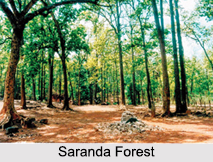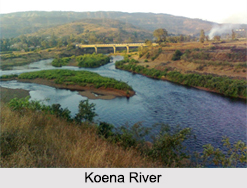 Saranda Forest in Jharkhand is a pristine world, rich with all its natural splendour. It is a dense forest situated in the hilly region of West Singhbhum district. The forest covers an area of 820 square kilometres which was previously the private hunting place of the Singh Deo family of Saraikela.
Saranda Forest in Jharkhand is a pristine world, rich with all its natural splendour. It is a dense forest situated in the hilly region of West Singhbhum district. The forest covers an area of 820 square kilometres which was previously the private hunting place of the Singh Deo family of Saraikela.
This region used to be the personal hunting reserve of the Singh Deo family who were the earlier royal family of Saraikela. The forest covers an area of 820 kilometres. Saranda literally means seven hundred hills. This part of India hosts a lot of Primitive Tribal Group, who are ignorant of the modern development. Some tribes use sound and also sign languages.
Location of Saranda Forest
Saranda Forest is situated at the hilly region in the West-Singhbhum district in the state of Jharkhand.
Flaura and Fauna of Saranda Forest
This forest is loaded with exciting flora and fauna. The thickness of the forest itself is picturesque to watch because it is covered with chiefly a single type of tree "Saal". The composure, wilderness, the depth all adds up to a must have experience in this part.
Apart from the Sal trees there are many other trees also. This forest is ornamented with a number of herbs and shrubs. Although Saal is a deciduous tree and sheds its leaves in early summer, the forest undergrowth is generally evergreen, which has such trees as mangoes, Jamun, jackfruit, and piar. Other important trees are mahua, kusum, tilai, harin hara (Armossa rohitulea), gular (Fiscus glomerata) and asan.
Saranda Forest is a golden treasure of wildlife. This forest is a home of the endangered flying lizard. This place is enriched with mammals, birds and reptiles. The wild elephants of this place are well known in the nation. Sambhar and Cheetal are very common. The tigers are notably countable but they are present in this forest. Bison and Leopard are commonly found in this forest.
The tigers are notably countable but they are present in this forest. Bison and Leopard are commonly found in this forest.
Saranda Forest is inhabited by the `ho` people. Thalkobad is a scenic village at a height of 550 metres (1,800 ft) in the heart of the forest. Thalkobad is about 46 kilometres (29 metres) from Manoharpur, and about 160 kilometres (99 metres) from Jamshedpur.
Attractions of Saranda Forest
Following are the attractions of Saranda Forest:
Koena River: The River Koena is by far the most significant river of this division. It derives in the great south of Bhangaon village on the Bonai border. It runs for about 80 kilometres through this division and drains into the river Koel at Manoharpur.
Kiriburu: It is a famous tourist spot in Saranda Forest. Kiriburu is a lovely place in Saranda at a height of 2800 ft. The view of sunrise and sunset is noteworthy from this picturesque hill station. The guest house is an important view point to visit the entire area of Saranda and its neighbour. Ligirada Swamp is another botanical paradise spanning over 7-8 acres. It is narrow marshy land and 4 kilometres away from Thalkobad Forest rest House.
Toybo Falls: Toybo Falls is 20 kilometres away from Thalkobad. The valley of this falls is an ideal play ground for the elephants who frequently visits this place.
In Saranda Forest, there are many temples to be paid a visit. Among them the famous temple of Mahadeva is located near Goelkera situated deep inside the forest. In the month of Shravana a large number of devotees come every year. Maa Giri Rajeshwrai Temple is situated 10 kilometres from Kiriburu. During Navaratri a festival happens at this temple.
Saranda Development Plan
Saranda development plan or SDP is stand for developing the Maoist stricken villages in the Saranda Forest. There are approximately 7000 tribal households with a population of 36,500 in 56 villages. The main elements of the SDP are to build houses for 6,000 households under the Indira Awaas Yojana which have previously been sanctioned in December 2011.



















